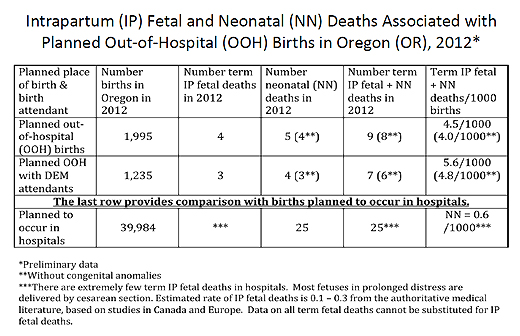Two links today for denialism blog readers, both are pretty thought provoking. The first, from Amy Tuteur, on the newly-released statistics on homebirth in Oregon. It seems that her crusade to have the midwives share their mortality data is justified, as when they were forced to release this data in Oregon, planned homebirth was about 7-10 times more likely to result in neonatal mortality than planned hospital birth.
I’m sure Tuteur won’t mind me stealing her figure and showing it here (original source of data is Judith Rooks testimony):

Armed with data such as these, it needs to become a point of discussion for both obstetricians and midwives that out of hospital births have a dramatically-higher neonatal mortality, and this is worse for midwives without nursing training (the DEM or direct-entry-midwives). It’s their body and their decision, but this information should be crucial to informing women as to whether or not they should take this risk. It also is only a reflection of neonatal mortality, one could also assume it speaks to higher rates of morbidity as well, as longer distances and poorer recognition of fetal distress and complications will lead to worse outcomes when the child survives. It should be noted this data is also consistent with nationwide CDC data on homebirth DEMs, and actually better than midwife data for some states like Colorado.
The second article worth pointing out today (even though it’s old) is from Michael Shermer in Scientific American on the liberal war on science. Regular readers know that I’m of the belief there isn’t really a difference between left and right-wing ideology on acceptance of science, it just means they just reject different findings that collide with their ideology.
The left’s war on science begins with the stats cited above: 41 percent of Democrats are young Earth creationists, and 19 percent doubt that Earth is getting warmer. These numbers do not exactly bolster the common belief that liberals are the people of the science book. In addition, consider “cognitive creationists”—whom I define as those who accept the theory of evolution for the human body but not the brain. As Harvard University psychologist Steven Pinker documents in his 2002 book The Blank Slate (Viking), belief in the mind as a tabula rasa shaped almost entirely by culture has been mostly the mantra of liberal intellectuals, who in the 1980s and 1990s led an all-out assault against evolutionary psychology via such Orwellian-named far-left groups as Science for the People, for proffering the now uncontroversial idea that human thought and behavior are at least partially the result of our evolutionary past.
There is more, and recent, antiscience fare from far-left progressives, documented in the 2012 book Science Left Behind (PublicAffairs) by science journalists Alex B. Berezow and Hank Campbell, who note that “if it is true that conservatives have declared a war on science, then progressives have declared Armageddon.” On energy issues, for example, the authors contend that progressive liberals tend to be antinuclear because of the waste-disposal problem, anti–fossil fuels because of global warming, antihydroelectric because dams disrupt river ecosystems, and anti–wind power because of avian fatalities. The underlying current is “everything natural is good” and “everything unnatural is bad.”
Whereas conservatives obsess over the purity and sanctity of sex, the left’s sacred values seem fixated on the environment, leading to an almost religious fervor over the purity and sanctity of air, water and especially food.
I’m worried that Shermer has confused liberal Luddism with denialism, and I would argue some anti-technology skepticism is healthy and warranted. While I agree that the anti-GMO movement does delve into denialist waters with regularity, these are not good examples he has chosen. One needs to be cautious with technology, and it’s a faith-based assumption that technology can solve all ills. I’m with Evgeny Morozov on this one, the assumption there is (or should be) a technological fix for every problem has become almost a religious belief system. Appropriately including the potential perils of a technology in its cost-benefit analysis is not a sign of being anti-science. Even overblowing specific risks because of individual values isn’t really anti-science either. It might be anti-human to put birds before human needs as with wind turbines, but no one is denying that wind turbines generate electricity. And while liberals may be overestimating the risk of say, nuclear waste generation over carbon waste generation (guess which is a planet-wide problem!), it doesn’t mean they don’t think nuclear power works or is real. They just have an arguably-skewed risk perception, which is an established problem in cases of ideological conflict with science or technology. There is also reasonable debate to be had over the business-practices of corporations (Monsanto in his example), which need and deserve strong citizen push-back and regulation to prevent anti-competitive or abusive behavior.
Anti-science requires the specific rejection of data, the scientific method, or strongly-supported scientific theory due to an ideological conflict, not because one possesses superior data or new information. I don’t think Shermer actually listed very good examples of this among liberals. If you’re going to talk about GMO denialism, don’t complain about people fighting with Monsanto, talk about how anti-GMO advocates make up crazy claims about the foods (see natural news for example) such as that they cause autism, or cancer. And even then it’s difficult to truly say this is a completely liberal form of denialism as Kahan’s work shows again, there is a pretty split ideological divide on GMO.
I agree that liberals are susceptible to anti-science and the mechanism is the same – ideological conflict with scientific results. However, the liberal tendency towards skepticism of technology is healthy in moderation, and anti-corporatism is not automatically anti-science. In an essay that was striving to say we must be less ideological and more pragmatic, Shermer has wrongly lumped in technological skepticism, and anti-corporatism with science denial.
Leave a Reply